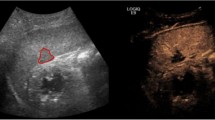Abstract
Introduction
Pelvic fracture may be accompanied by severe bleeding. Computed tomography (CT) is a gold standard diagnostic tool in stable trauma patients. Contrast extravasation detected on CT of pelvis is a sign of hemorrhage, but its significance is not clear. We aimed to evaluate the need for angiography in patients with pelvic fracture and CT revealed contrast extravasation. We tried to identify parameters that might help to choose patients who will benefit from therapeutic angiography.
Methods
Electronic medical records of patients with pelvic fracture admitted to Level II Trauma Center during 10 years were retrospectively reviewed. Patients who had contrast extravasation on CT were included. Data base consisted of demographics, injury severity, initial physiologic parameters, laboratory data, results of CT and angiography.
Results
Forty out of 396 patients had contrast extravasation detected by CT. Twelve patients underwent angiography and 4 of them benefited from embolization. The sensitivity of contrast extravasation in evaluating the need for embolization was 1.0 (95% CI 0.398, 1.0), positive predictive value was 0.1 (95% CI 0.028, 0.237), and the negative predictive value was 1.0 (95% CI 0.990, 1.0).
Conclusion
The role of angiography in stable patients with pelvic fracture and CT identified contrast extravasation remains questionable. Most of these patients are not in need of angioembolization.

Similar content being viewed by others
References
Incagnoli P, Puidupin A, Ausset S, et al. Early management of severe pelvic injury (first 24 hours). Anaesth Crit Care Pain Med. 2019;38(2):199–207.
Arvieux C, Thony F, Broux C, et al. Current management of severe pelvic and perineal trauma. J Visc Surg. 2012;149(4):e227–38.
Coccolini F, Stahel PF, Montori G. Pelvic trauma: WSES classification and guidelines. World J Emerg Surg. 2017;18(12):5.
Agri F, Bourgeat M, Becce F, et al. Association of pelvic fracture patterns, pelvic binder use and arterial angio-embolization with transfusion requirements and mortality rates; a 7-year retrospective cohort study. BMC Surg. 2017;17(1):104.
Geeraerts T, Chhor V, Cheisson G, et al. Clinical review: Initial management of blunt pelvic trauma patients with haemodynamic instability. Crit Care. 2007;11(1):204.
Cullinane DC, Schiller HJ, Zielinski MD. Eastern Association for the Surgery of Trauma practice management guidelines for hemorrhage in pelvic fracture update and systematic review. J Trauma. 2011;71(6):1850–68.
Hosmer DW, Lemeshow S, Sturdivant RX. Chapter 4, Model-building strategies and methods for logistic regression. In: Applied Logistic Regression. 3rd ed. New York: Wiley; 2013. p. 89–151.
Peacock JL, Kerry SM, Balise RR. Chapter 10, Multifactorial analyses. In: Presenting medical statistics from proposal to publication. 2nd ed. New York: Oxford University Press; 2017. p. 134–60.
Pizanis A, Pohlemann T, Burkhardt M, Aghayev E, Holstein JH. Emergency stabilization of the pelvic ring: clinical comparison between three different techniques. Injury. 2013;44(12):1760–4.
Vaidya R, Waldron J, Scott A, Nasr K, Vaidya R, et al. Angiography and embolization in the management of bleeding pelvic fractures. J Am Acad Orthop Surg. 2018;26(4):68–76.
El-Haj M, Bloom A, Mosheiff R, et al. Outcome of angiographic embolisation for unstable pelvic ring injuries: factors predicting success. Injury. 2013;44(12):1750–5.
Hagiwara K, Minakawa H, Fukushima A, et al. Predictors of death in patients with life-threatening pelvic hemorrhage after successful transcatheter arterial embolization. J Trauma. 2003;55(4):696–703.
Skitch S, Engels PT. Acute Management of the Traumatically Injured Pelvis. Emerg Med Clin North Am. 2018;36(1):161–79.
Juern JS, Milia D, Codner P, et al. Clinical significance of computed tomography contrast extravasation in blunt trauma patients with a pelvic fracture. J Trauma Acute Care Surg. 2017;82:138–40.
Verbeek DO, Zijlstra IA, van der Leij C, et al. Management of pelvic ring fracture patients with a pelvic “blush” on early computed tomography. J Trauma Acute Care Surg. 2014;76:374–9.
Funding
No funding was provided.
Author information
Authors and Affiliations
Contributions
Conceptualization: IJ, YH. Methodology: IJ, YH. Formal analysis and investigation: IJ, IA, JH. Writing—original draft preparation: JH, YH. Writing—review and editing: IJ, ZS, IA.
Corresponding author
Ethics declarations
Conflicts of interest
The authors declare that they have no conflict of interest.
Ethics approval
This study was approved by the institution’s research ethics committee (protocol 62-20).
Rights and permissions
About this article
Cite this article
Hammerschlag, J., Hershkovitz, Y., Ashkenazi, I. et al. Angiography in patients with pelvic fractures and contrast extravasation on CT following high-energy trauma. Eur J Trauma Emerg Surg 48, 1939–1944 (2022). https://doi.org/10.1007/s00068-021-01628-w
Received:
Accepted:
Published:
Issue Date:
DOI: https://doi.org/10.1007/s00068-021-01628-w




